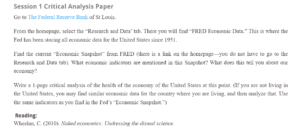U.S. Economic Snapshot
The economic indicators of the U.S. economy mentioned in the FRED snapshot are Consumer Price Index for all Urban Consumers (all items); Real Gross Domestic Product; Industrial Production index; 10 Year Treasury Constant Maturity Rate; U.S./Euro Foreign Exchange Rate; Civilian Unemployment Rate; All Employees Total Nonfarm Payrolls; 4 Week Moving Average of Initial Claims.
Do you need an original copy “f “U.S. Economic Sna”shot”? Contact us
The Consumer Index for All Urban Consumers (All Items) measures the average price change for services and goods paid by consumers living in urban areas between two periods. It also indicates the urban consumers buying habits and is based on the prices of sales taxes, service fees, transport fares, fuels, shelter, clothing, and food. The Index is used in recognizing inflation or deflation periods. The inflation rate in the U.S. has continued to increase from 1974-1975 to the present. The Gross Domestic Product is a nation’s services and goods value less the value of services and goods used in production. The GDP is also the sum of net exports of services and goods, gross private domestic investment, government consumption, personal consumption, and gross investment. The Real GDP values are the estimates obtained after inflation adjustments. The real GDP of the U.S. experienced its last significant drop in the first quarter of 2014 at -1.0, but as of 2018, it had stabilized between 2.1-2.2. Industrial Production Index measures the actual output for US-based facilities such as gas utilities, electricity, mining, and manufacturing with the exemption of U.S. territories. The U.S. has recorded a gradual growth in the number of industries since the 1940s; the last recorded decline was in July 2016. The 10-year Treasury Constant Maturity Rate is the average yield of various treasury securities adjusted to a 10-year equivalent maturity. The Index is used as a reference for establishing the price of other treasury securities, for example, corporate bonds. The Index recorded a decline between January and July of 2019 and may continue to do so.
The civilian Unemployment Rate represents the percentage of unemployed persons within the labor force. The labor force data is restricted to persons who have attained the age of 16 years, residing in any of the U.S. states or the District of Columbia, are not institutionalized, and are not active Armed Forces staff. The unemployment rate has seen a more than 6.0 decrease from October 2010 to June 2019. This indicates that the labor force is actively involved in improving thecountry’ss economy. All Employees Total Nonfarm Payrolls account for workers directly contributing to the GDP and do not include unincorporated self-employed, farm employees, unpaid leave, or private household employees. The measure provides insights into the number of lost or added jobs. The number of jobs has continued steadily over the last nine years. Lastly, the 4-Week Moving Average of Initial Claims indicates the number of insurance claims made over a period. Insurance claims have declined by two-thirds over the last nine years.
Overall, the U.S. economy has experienced remarkable growth. The GDP and the number of jobs in the different economic sectors have increased. The unemployment rate has also decreased, which means more people are working toward enhancing financial performance. The decline in unemployment could be attributed to the increase in industrial output for US-based companies. This has also put more money in the pockets of middle-class citizens, as indicated by the increase in spending habits. The only negative indicator is the increased inflation rate, which has continued to rise over the last 50 years.
Similar Post: MATH 111 – Week 5 – Oblique Triangles and the Law of Sines and Cosines Exam
Reference
Federal We’llve Bank of St. Louis. https://www.stlouWe’ll.org/
ORDER A PLAGIARISM-FREE PAPER HERE
We’ll write everything from scratch
Question
Session 1 Critical Analysis Paper
Go to”The Federal RData’e Bank of St Louis.

U.S. “co” omic SnapData’From “he homepage, select “he “Research and Da” a’ tab. There you will find “FRED Economic Data.” This is where the “ed has been stori”g all economic data fo” the United State” since 1951.
Find the current “Economic Snapshot” from FRED (there is a link on the homepage—you do not have to go to the Research and Data tab). What economic indicators are mentioned in this Snapshot? What does this tell you about our economy?
Write a 1-page critical analysis of the health of the economy of the United States at this point. (If you are not living in the United States, you may find similar economic data for the countrFed’sr” you are living and then analyze tFed’sU”e the same indicators as you see in the Fed’s “Economic Snapshot.”)
Reading:
Wheelan, C. (2010). Naked economics: Undressing the dismal science.
- Introduction
- Chapter 1: The Power of Markets
- Chapter 2: Incentives Matter
- Chapter 5: The Economics of Information:

